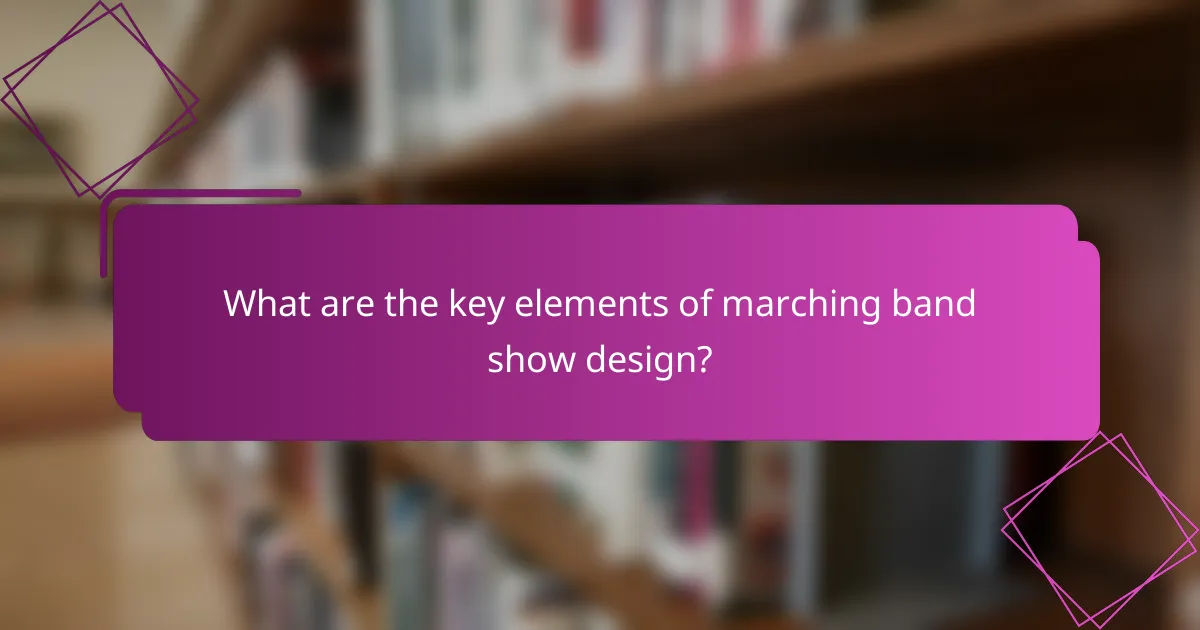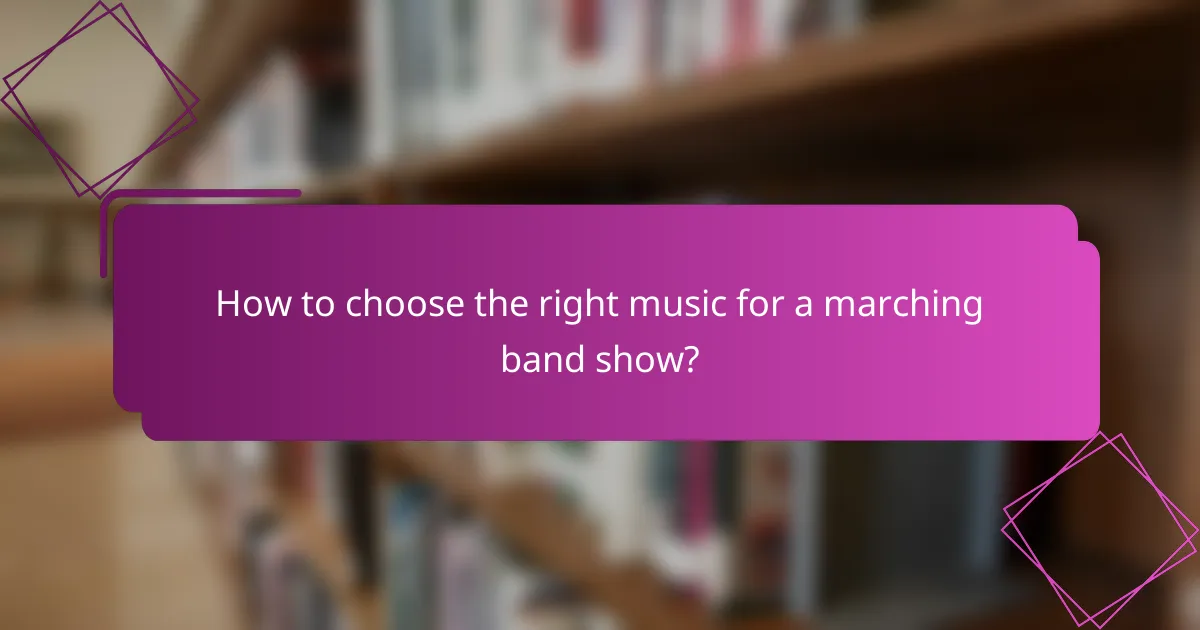Designing a marching band show requires a thoughtful approach that integrates strong themes, captivating choreography, and striking visual effects to create a memorable experience. By focusing on thematic development and visual storytelling, designers can craft performances that resonate emotionally with audiences while showcasing the band’s musical talents. Each element, from musical arrangement to choreography, plays a vital role in delivering an engaging and cohesive presentation.

How to design a marching band show effectively?
To design a marching band show effectively, focus on creating a cohesive experience that combines strong themes, engaging choreography, and impactful visual effects. Consider the audience’s perspective and aim for a memorable performance that resonates emotionally and visually.
Incorporate strong themes
Strong themes serve as the backbone of a marching band show, guiding the narrative and visual elements. Choose a theme that resonates with the audience, such as historical events, literature, or cultural motifs, and ensure it is reflected in the music, visuals, and choreography.
For example, a show based on a classic novel can incorporate relevant musical selections and visual imagery that evoke the story’s essence. This thematic consistency helps create a more immersive experience for the audience.
Utilize visual effects
Visual effects enhance the overall impact of a marching band performance by adding depth and excitement. Consider using props, backdrops, and lighting to complement the theme and engage the audience visually.
Incorporating elements like color guard routines or innovative formations can also elevate the visual experience. Ensure that these effects are synchronized with the music and choreography to maintain coherence throughout the performance.
Engage with choreography
Choreography is crucial in a marching band show, as it brings the music to life through movement. Develop routines that are not only visually appealing but also enhance the musical phrases and themes.
Incorporate a variety of formations and movements that reflect the emotional highs and lows of the music. This dynamic interplay between music and movement can captivate the audience and create a memorable performance.
Plan for audience interaction
Engaging the audience can significantly enhance the impact of a marching band show. Consider incorporating elements that invite audience participation or create a connection, such as call-and-response segments or thematic storytelling.
Additionally, be mindful of the performance’s pacing and structure to maintain audience interest. A well-timed moment of interaction can leave a lasting impression and foster a deeper connection with the performance.
Ensure musical cohesion
Musical cohesion is essential for a successful marching band show, as it ties together the various elements of the performance. Select music that aligns with the chosen theme and flows seamlessly from one piece to another.
Consider the arrangement of the music, ensuring that transitions are smooth and that the overall sound is balanced. This attention to musical detail will enhance the audience’s experience and reinforce the show’s narrative.

What are the key elements of marching band show design?
The key elements of marching band show design include thematic development, visual storytelling, musical arrangement, and choreography integration. Each of these components plays a crucial role in creating a cohesive and engaging performance that captivates the audience.
Thematic development
Thematic development involves establishing a central idea or concept that guides the entire show. This theme can be drawn from literature, history, or abstract concepts, and should resonate with both performers and the audience.
When developing a theme, consider how it can be expressed through music, visuals, and movement. A well-defined theme helps unify the performance and enhances the emotional impact, making it more memorable.
Visual storytelling
Visual storytelling is about conveying the theme through visual elements such as formations, props, and color schemes. Effective visual storytelling can elevate the performance by creating a narrative that complements the music.
To enhance visual storytelling, use formations that reflect the theme and incorporate props that add depth. For example, a show based on a fairy tale might use whimsical props and formations that mimic the story’s characters and settings.
Musical arrangement
Musical arrangement is the process of selecting and arranging music that aligns with the theme and enhances the overall performance. The arrangement should include dynamic contrasts, tempos, and harmonies that support the visual elements.
When arranging music, consider the skill level of the band and the desired emotional impact. A mix of familiar and original compositions can engage the audience while showcasing the band’s abilities.
Choreography integration
Choreography integration refers to the seamless blending of movement with music and visual elements. This aspect is crucial for maintaining the flow of the performance and ensuring that all components work together harmoniously.
To achieve effective choreography integration, ensure that movements are timed with musical cues and align with visual formations. Regular practice and collaboration between the music and visual teams can help create a cohesive performance that captivates the audience.

What themes work best for marching band shows?
Effective marching band show themes resonate with audiences and enhance the overall performance experience. Popular themes often include historical narratives, fantasy worlds, cultural explorations, and seasonal motifs, each offering unique opportunities for visual and musical expression.
Historical themes
Historical themes draw inspiration from significant events, figures, or eras, allowing bands to tell compelling stories through music and movement. Examples include shows focused on the American Revolution, ancient civilizations, or notable leaders. When designing a historical show, consider integrating period-appropriate costumes and props to enhance authenticity.
These themes can evoke strong emotional responses and create a sense of connection with the audience. However, it’s crucial to ensure accuracy and sensitivity in representation to avoid misinterpretation or offense.
Fantasy themes
Fantasy themes transport audiences to imaginative realms, often inspired by literature, mythology, or folklore. Shows might feature elements like dragons, enchanted forests, or heroic quests, allowing for creative choreography and vivid visual effects. Incorporating dramatic lighting and colorful costumes can further immerse viewers in the fantastical narrative.
When selecting a fantasy theme, consider the balance between creativity and clarity. Ensure that the storyline is coherent and that the audience can easily follow the journey being depicted.
Cultural themes
Cultural themes celebrate the traditions, music, and art of specific societies or regions. These shows can highlight diverse heritages, such as African, Asian, or Latin American cultures, showcasing their unique rhythms and visual styles. Engaging with cultural consultants can help ensure respectful and accurate representation.
Incorporating authentic instruments, dance styles, and traditional costumes can enrich the performance. However, it’s essential to approach cultural themes with sensitivity and respect to avoid cultural appropriation.
Seasonal themes
Seasonal themes align with specific times of the year, such as autumn, winter, spring, or summer. These shows often reflect the moods, colors, and traditions associated with each season, like a celebration of harvest in fall or a winter wonderland. Utilizing seasonal imagery and music can create a relatable experience for the audience.
When designing a seasonal show, consider how the theme can evolve throughout the performance to reflect changes within the season. This dynamic approach can keep the audience engaged and enhance the overall impact of the show.

What visual effects enhance marching band performances?
Visual effects play a crucial role in enhancing marching band performances by creating a captivating atmosphere that engages the audience. These effects include lighting, props, and costume design, all of which work together to amplify the overall impact of the show.
Lighting techniques
Lighting techniques can dramatically transform the visual experience of a marching band performance. Using a combination of spotlights, colored gels, and LED lights, bands can create dynamic moods and highlight specific moments in their routines. For outdoor performances, consider the time of day and natural light conditions to optimize visibility and effect.
When implementing lighting, ensure that it complements the music and choreography. Avoid overly bright lights that can distract from the performance; instead, aim for balanced illumination that enhances key visual elements. A common approach is to synchronize lighting changes with musical crescendos for maximum impact.
Props and set design
Props and set design add depth and context to a marching band show, allowing for storytelling and thematic expression. Common props include flags, banners, and thematic structures that can be moved or manipulated during the performance. It’s essential to choose props that are lightweight and easy to handle to maintain the flow of the show.
Consider the theme of the performance when selecting props. For instance, a show centered around nature might incorporate elements like trees or flowers, while a historical theme could feature period-specific items. Ensure that all props are securely anchored to prevent accidents during the performance.
Costume design
Costume design is vital in establishing the visual identity of a marching band performance. Costumes should reflect the theme and enhance the overall aesthetic while allowing for freedom of movement. Fabrics that are breathable and flexible are ideal, especially for outdoor performances in varying weather conditions.
When designing costumes, consider color schemes that align with the visual effects and props. Cohesive color palettes can create a striking visual impact. Additionally, avoid overly complex designs that may hinder performers’ movements or distract from the music. Simple yet effective embellishments can elevate the overall look without compromising functionality.

How to choose the right music for a marching band show?
Choosing the right music for a marching band show involves selecting pieces that resonate with both the performers and the audience while aligning with the overall theme of the performance. Consideration of musical complexity, emotional impact, and audience engagement is crucial for a successful show.
Consider audience demographics
Understanding the demographics of your audience is essential when selecting music for a marching band show. Factors such as age, cultural background, and familiarity with certain genres can influence how well the music is received. For instance, younger audiences may respond better to contemporary pop or rock, while older audiences might prefer classic or traditional pieces.
Additionally, local cultural influences can play a significant role. If performing at a community event, incorporating local favorites or regional styles can enhance audience connection and enjoyment. Always aim for a balance that keeps the majority engaged while still challenging the band musically.
Match music to theme
The music chosen for a marching band show should directly reflect the theme of the performance. A cohesive theme helps unify the visual and auditory elements, creating a more impactful experience. For example, if the theme is “The Seasons,” consider using pieces that evoke the feelings associated with each season, such as light, airy compositions for spring and more dramatic pieces for winter.
When selecting music, ensure that it not only fits the theme but also allows for creative visual interpretations. This could involve choreography, color guard routines, or props that enhance the musical narrative. A well-matched theme and music can elevate the overall performance and leave a lasting impression on the audience.
